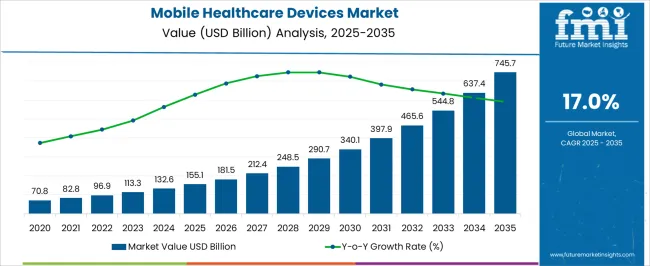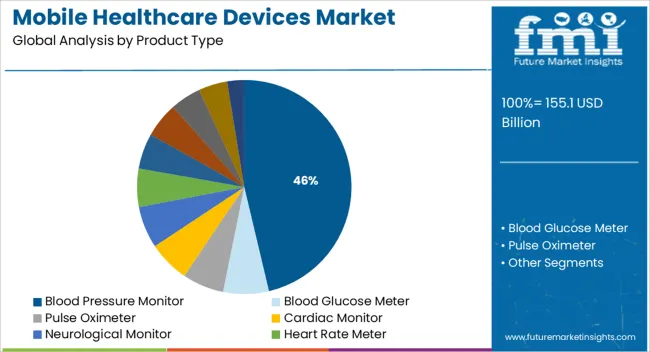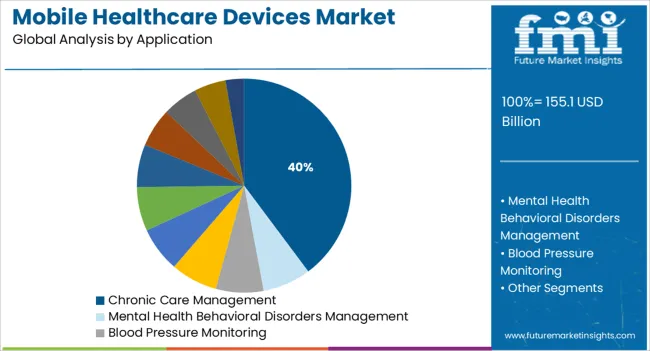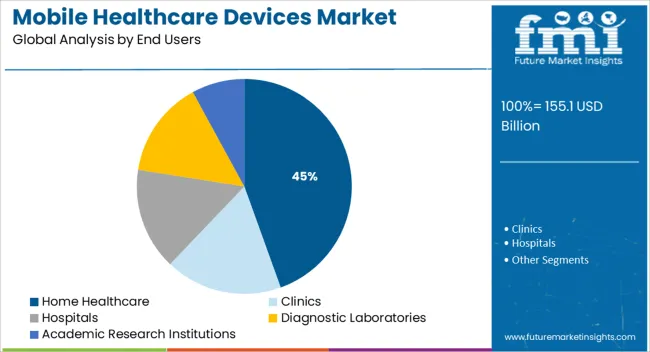The Mobile Healthcare Devices Market is estimated to be valued at USD 155.1 billion in 2025 and is projected to reach USD 745.7 billion by 2035, registering a compound annual growth rate (CAGR) of 17.0% over the forecast period.

| Metric | Value |
|---|---|
| Mobile Healthcare Devices Market Estimated Value in (2025 E) | USD 155.1 billion |
| Mobile Healthcare Devices Market Forecast Value in (2035 F) | USD 745.7 billion |
| Forecast CAGR (2025 to 2035) | 17.0% |
The mobile healthcare devices market is expanding rapidly as healthcare providers and patients increasingly turn to portable monitoring tools to manage chronic conditions and improve care accessibility. The shift toward value based care and remote patient management is driving adoption of mobile technologies that offer continuous health tracking, data sharing, and personalized care interventions.
Integration with smartphones, wearables, and cloud based platforms has enhanced usability and expanded use cases from clinical to home settings. Regulatory support for telehealth services and increased awareness around early intervention are also contributing to sustained demand.
These devices support both preventive and chronic disease management while enabling healthcare systems to reduce costs and optimize outcomes. The future outlook is strengthened by ongoing innovation in biosensors, battery life, and interoperability features which will further accelerate mainstream acceptance and scale of mobile healthcare solutions.
The market is segmented by Product Type, Application, and End Users and region. By Product Type, the market is divided into Blood Pressure Monitor, Blood Glucose Meter, Pulse Oximeter, Cardiac Monitor, Neurological Monitor, Heart Rate Meter, ECG Monitor, Peak Flow Meter, Sleep Apnea Meter, Multiparameter Tracker Others, and Fitbit Or Smart Watches. In terms of Application, the market is classified into Chronic Care Management, Mental Health Behavioral Disorders Management, Blood Pressure Monitoring, Diabetes Management, Cancer Management, General Health, Fitness, Women's Health, Nutrition, Medical Management, and Others. Based on End Users, the market is segmented into Home Healthcare, Clinics, Hospitals, Diagnostic Laboratories, and Academic Research Institutions. Regionally, the market is classified into North America, Latin America, Western Europe, Eastern Europe, Balkan & Baltic Countries, Russia & Belarus, Central Asia, East Asia, South Asia & Pacific, and the Middle East & Africa.

The blood pressure monitor segment is expected to generate 46.30% of total market revenue by 2025, making it the leading product type. This prominence is attributed to the global rise in hypertension cases and the growing emphasis on cardiovascular health management.
Blood pressure monitors are widely used for early detection and ongoing monitoring, particularly among aging populations and patients with lifestyle related conditions. Their affordability, ease of use, and integration with mobile applications have made them indispensable in both clinical and home environments.
Advances in cuffless technology and wireless connectivity are enhancing user compliance and enabling real time data transmission to caregivers and healthcare providers. The combination of medical necessity, technological enhancements, and patient centric features has established blood pressure monitors as the most utilized and revenue generating category in the product type segment.

The chronic care management segment is projected to account for 39.80% of total market revenue by 2025 within the application category. This growth is being driven by the increasing burden of long term conditions such as diabetes, hypertension, and respiratory diseases, which require regular monitoring and patient engagement.
Mobile healthcare devices offer a non invasive, cost effective, and scalable solution for managing chronic illness outside traditional care settings. The integration of predictive analytics, medication tracking, and remote consultations further supports comprehensive care delivery.
Health systems and payers are increasingly incorporating mobile tools into chronic care pathways to reduce hospital readmissions and improve adherence. As a result, chronic care management has emerged as a core application, enabled by technology and aligned with long term healthcare system sustainability.

The home healthcare segment is projected to capture 44.50% of total market revenue by 2025, positioning it as the most dominant end user category. This trend is fueled by the growing preference for in home care delivery, particularly among elderly patients and those managing chronic illnesses.
Mobile healthcare devices empower individuals to monitor their health status, communicate with clinicians, and make informed decisions from the comfort of their homes. The shift toward aging in place and the rising cost of institutional care have accelerated demand for home based monitoring solutions.
Additionally, caregivers and family members benefit from enhanced visibility into patient conditions, leading to improved intervention timing and care coordination. With the convergence of convenience, cost effectiveness, and quality outcomes, the home healthcare segment continues to lead market adoption across the mobile healthcare ecosystem.
As venous disorders become more common and more new products are approved to meet this demand, the market for mobile healthcare devices is anticipated to develop significantly throughout the forecast period. The market is expected to develop as a result of rising disease awareness, the growing value of early detection, and rising spending on chronic illnesses.
Additionally, the major market participants are spending money on the research and development of technologically improved products, which will enhance the use of mobile healthcare device products in both developed and developing nations worldwide.
The widespread usage of mobile phones and PDAs benefits many industries, including the healthcare industry. Hospitals increasingly depend on mobile healthcare applications for interoperability and safe care coordination between patients and healthcare workers as a result of the technology that offers advanced healthcare services.
Healthcare delivery is made actionable by the summed-up valuation of healthcare devices, which includes wearables like Fitbit, blood and cardio monitoring tools, and the increased use of remote monitoring programs and mobile audio/video communication. The mobile healthcare devices market is anticipated to save millions in terms of healthcare administration.
The adoption of mobile healthcare device goods is hindered by low levels of disease awareness, high product costs, weak economic conditions, and unfavorable insurance systems worldwide.
However, the introduction of new, inexpensive products and increased market penetration efforts in these regions may present profitable growth prospects for market participants in mobile healthcare devices.
Both the driving factors that are boosting the demand for mobile healthcare devices and the restraining factors that are stifling its expansion are thoroughly explored, along with their effects on the global market for mobile healthcare devices.
The given analysis also identifies and goes into detail about the trends that are influencing the market and influencing its growth. Additionally, there are also qualitative factors, including operational hazards and significant market hurdles.
Additionally, an increase in the demand for advanced healthcare facilities, an increase in spending on research and development, and an increase in the usage of mobile healthcare devices by healthcare authorities have all changed many aspects of medical practice. The widespread use of mobile healthcare devices in healthcare facilities has sped up the growth of the global market for these devices.
Due to the rise in the incidence of chronic diseases such as lung illnesses, diabetes, heart issues, and hypertension, as well as the rates of associated mortality and morbidity, there has been a surge in need for self-monitoring and user-friendly technologies in recent years.
Health records and medication reminders are provided by a single text message or through online treatments using health applications based on personal health records (PHR), lifestyle, nutrition, well-being, and personal management systems.
Mobile healthcare devices market, including ECG monitors, multi-parameter trackers, blood pressure and cardiac monitors, glucose monitors, pulse oximeters, neurological monitoring devices, sleep pane devices, and other mobile healthcare devices, have benefited from the development of mobile healthcare devices.
Geographically, the mobile healthcare devices marketis segmented into seven regions, namely North America, Latin America, Western Europe, Eastern Europe, Asia Pacific Excluding Japan (APEJ), Japan and the Middle East and Africa (MEA). North America has a major share in terms of value and volume owing to large number of manufacturers and growing awareness about the upcoming devices.
Majority of USA consumers have concluded that mobile healthcare devices are helping them to improve the quality of their lives by monitoring their daily activities. APEJ and Latin American are anticipated to present immense growth opportunities for market players during the forecast period.
In APEJ, electronics and medical device industries with their improved efficiency of the healthcare delivery system as well as healthcare workforce are expected to drive growth in the region through 2029. Mobile healthcare device market is largely driven by the vital signs monitoring devices and In Vitro Diagnostics (IVDs).
The key players in the global mobile healthcare devices marketare:
Globally, the manufacturers of mobile healthcare devices are implementing strategies such as merger and acquisitions while launching novel technology advancements by using unique medical sensors and mobile applications (apps).
The research report presents a comprehensive assessment of the market and contains thoughtful insights, facts, historical data, and statistically supported and industry-validated market data. It also contains projections using a suitable set of assumptions and methodologies. The research report provides analysis and information according to market segments such as geographies, and applications.
The report is a compilation of first-hand information, qualitative and quantitative assessment by industry analysts, inputs from industry experts and industry participants across the value chain. The report provides in-depth analysis of parent market trends, macro-economic indicators and governing factors along with market attractiveness as per segments. The report also maps the qualitative impact of various market factors on market segments and geographies.
The global mobile healthcare devices market is estimated to be valued at USD 155.1 billion in 2025.
The market size for the mobile healthcare devices market is projected to reach USD 745.7 billion by 2035.
The mobile healthcare devices market is expected to grow at a 17.0% CAGR between 2025 and 2035.
The key product types in mobile healthcare devices market are blood pressure monitor, blood glucose meter, pulse oximeter, cardiac monitor, neurological monitor, heart rate meter, ecg monitor, peak flow meter, sleep apnea meter, multiparameter tracker others and fitbit or smart watches.
In terms of application, chronic care management segment to command 39.8% share in the mobile healthcare devices market in 2025.






Our Research Products

The "Full Research Suite" delivers actionable market intel, deep dives on markets or technologies, so clients act faster, cut risk, and unlock growth.

The Leaderboard benchmarks and ranks top vendors, classifying them as Established Leaders, Leading Challengers, or Disruptors & Challengers.

Locates where complements amplify value and substitutes erode it, forecasting net impact by horizon

We deliver granular, decision-grade intel: market sizing, 5-year forecasts, pricing, adoption, usage, revenue, and operational KPIs—plus competitor tracking, regulation, and value chains—across 60 countries broadly.

Spot the shifts before they hit your P&L. We track inflection points, adoption curves, pricing moves, and ecosystem plays to show where demand is heading, why it is changing, and what to do next across high-growth markets and disruptive tech

Real-time reads of user behavior. We track shifting priorities, perceptions of today’s and next-gen services, and provider experience, then pace how fast tech moves from trial to adoption, blending buyer, consumer, and channel inputs with social signals (#WhySwitch, #UX).

Partner with our analyst team to build a custom report designed around your business priorities. From analysing market trends to assessing competitors or crafting bespoke datasets, we tailor insights to your needs.
Supplier Intelligence
Discovery & Profiling
Capacity & Footprint
Performance & Risk
Compliance & Governance
Commercial Readiness
Who Supplies Whom
Scorecards & Shortlists
Playbooks & Docs
Category Intelligence
Definition & Scope
Demand & Use Cases
Cost Drivers
Market Structure
Supply Chain Map
Trade & Policy
Operating Norms
Deliverables
Buyer Intelligence
Account Basics
Spend & Scope
Procurement Model
Vendor Requirements
Terms & Policies
Entry Strategy
Pain Points & Triggers
Outputs
Pricing Analysis
Benchmarks
Trends
Should-Cost
Indexation
Landed Cost
Commercial Terms
Deliverables
Brand Analysis
Positioning & Value Prop
Share & Presence
Customer Evidence
Go-to-Market
Digital & Reputation
Compliance & Trust
KPIs & Gaps
Outputs
Full Research Suite comprises of:
Market outlook & trends analysis
Interviews & case studies
Strategic recommendations
Vendor profiles & capabilities analysis
5-year forecasts
8 regions and 60+ country-level data splits
Market segment data splits
12 months of continuous data updates
DELIVERED AS:
PDF EXCEL ONLINE
Mobile Camping Toilet Market Size and Share Forecast Outlook 2025 to 2035
Mobile Phone Screen Underlayer Cushioning Material Market Size and Share Forecast Outlook 2025 to 2035
Mobile Application Store Market Size and Share Forecast Outlook 2025 to 2035
Mobile Money Market Forecast and Outlook 2025 to 2035
Mobile Application Testing Solution Market Size and Share Forecast Outlook 2025 to 2035
Mobile Cardiac Telemetry System Market Size and Share Forecast Outlook 2025 to 2035
Mobile Robots Market Size and Share Forecast Outlook 2025 to 2035
Mobile Crane Market Size and Share Forecast Outlook 2025 to 2035
Mobile Vascular Imaging Market Size and Share Forecast Outlook 2025 to 2035
Mobile Animal Inhalation Anesthesia Machine Market Size and Share Forecast Outlook 2025 to 2035
Mobile Unified Communications and Collaboration (UC&C) Solution Market Size and Share Forecast Outlook 2025 to 2035
Mobile Data Protection Market Size and Share Forecast Outlook 2025 to 2035
Mobile Medical Tablets Market Size and Share Forecast Outlook 2025 to 2035
Mobile WLAN Access Points Market Size and Share Forecast Outlook 2025 to 2035
Mobile Social Networks Market Size and Share Forecast Outlook 2025 to 2035
Mobile Printer Market Size and Share Forecast Outlook 2025 to 2035
Mobile Application Development Platform Market Size and Share Forecast Outlook 2025 to 2035
Mobile Threat Management Security Software Market Size and Share Forecast Outlook 2025 to 2035
Mobile Broadband Infrastructure Market Size and Share Forecast Outlook 2025 to 2035
Mobile Enterprise Application Development Platform Market Size and Share Forecast Outlook 2025 to 2035

Thank you!
You will receive an email from our Business Development Manager. Please be sure to check your SPAM/JUNK folder too.
Chat With
MaRIA